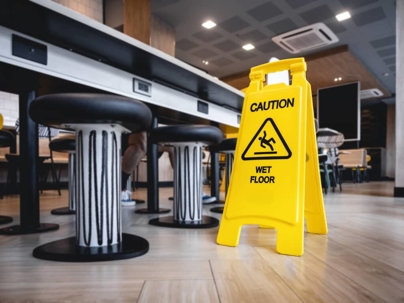When it comes to litigating premises liability claims in California, attorneys need to be intimately familiar with the circumstances surrounding their clients’ injuries, and the nuances of California laws regarding the key elements of these cases.
That includes not only the duty of care a landowner has for taking reasonable measures that keep their property in a safe condition (and the need to prove that duty was breached), but also the requirement that Plaintiffs prove the Defendant(s) were aware, in some form, of the unsafe condition.
This is known as notice, and it’s an important concept in premises cases:
Notice Requirement in Premises Liability Cases
In premises cases, property owners cannot argue they aren’t liable for injuries suffered by guests simply because they didn’t know about a dangerous condition. However, they’re usually not going to admit they did. Therefore, Plaintiffs have the burden of proving:
- The existence of a dangerous condition; and
- That the landowner had notice of the dangerous condition which caused their injury.
While it’s well-established that property owners are not “insurers” for the safety of their guests, California law does require landowners to “exercise reasonable care in keeping the premises reasonably safe.” (Ortega v. Kmart Corp.).
As such, property owners can be held financially liable for victims’ damages (i.e. their medical bills, lost income, and pain and suffering) when those damages arise from injuries caused by a dangerous condition the owner knew about, or should have known about.
Actual & Constructive Knowledge
Knowledge means knowing something, and for legal purposes, it can be broken down into two categories: actual and constructive.
- Actual knowledge means actually knowing something. If you actually know or knew about a hole in your driveway because you drive over it or see it every day, you have a duty to take steps to warn of that danger, or protect people from stepping into it.
- Constructive knowledge means something a person could reasonably be expected to know; in other words, something they should have known. If a contractor you hired to re-do your landscaping dug a hole in your driveway, you would constructively know of the hole because you were the person who hired them to perform work on your property. Even if you didn’t actually know about the hole (i.e. see it or were told about it), your obligations in regard to the hole would be the same as if you actually knew about it.
Actual knowledge and constructive knowledge are important concepts in tort actions, as they can form the basis for liability. Plaintiffs who bring premises liability claims, for example, must prove property owners had either actual or constructive notice of a dangerous condition.
Constructive Notice vs Actual Notice
The main differences between constructive notice and actual notice are:
- Actual notice – when a property owner has concrete knowledge of a dangerous condition.
- Constructive notice – when a property owner should know of a danger, because it would be reasonably expected.
Actual Notice
Plaintiffs may prove a property owner had actual notice of a dangerous condition when the dangerous condition was created by:
- The owner themselves; or
- An employee of the owner in the course of their employment;
Per California case law and the California Civil Jury Instructions (CACI 1012), a premises owner had actual notice of a dangerous condition if the condition was created by an employee acting within the scope of his / her employment (Hatfield v. Levy Bros). This is known as imputed notice, which is a legal way of saying that it is presumed a party has information because of their relationship with others who had actual notice of the information.
A premises owner would have actual notice of a dangerous condition whether they negligently created it themselves or one of their employees negligently created it in the course of performing work-related duties. For example, actual notice exists when:
- An owner leaves a stack of large boxes in the middle of an aisle;
- An employee spills liquid on the floor of a business;
- A worker removes a piece of equipment but leaves debris or parts of it behind.
Constructive Notice
Plaintiffs in premises cases may also establish notice as constructive notice. This can be done in various ways, such as by arguing:
- The dangerous condition existed long enough for a property owner, using reasonable care, to have discovered the hazard and repair it, protect against it, or adequately warn guests about it (CACI 1011). For example, Plaintiffs may argue a store owner failed to make regular or adequate inspections of their property, causing them to miss a large puddle on the floor that had been there for several hours. Generally, property owners have a duty to inspect areas of their premises open to the public continuously and frequently (Ortega v. K-Mart). In cases where dangerous conditions persisted for long periods of time, regardless of who created them, Plaintiffs and their attorneys can gather evidence such as inspection logs, video surveillance, and company policies regarding inspection frequency as part of their property accident investigations to show how defendants failed to follow their own procedures or rules, and/or how a simple inspection would have prevented the Plaintiff’s injury.
- A property owner had constructive notice through prior incidents, meaning there had been previous accidents involving the same or similar dangerous condition which caused the Plaintiff’s injury. For example, a history of documented complaints, accident reports about injured customers, and slip and fall lawsuits against the owner could be used to prove a landowner had constructive notice. To be admissible as evidence, however, the circumstances surrounding the prior incidents must be substantially similar to those at issue in the case (Simmons v. Southern Pac. Transportation Co.).
Other Issues: Subsequent Incidents & Mode of Operation
There are other closely related issues that may be raised when investigating notice and negligence. For example, Plaintiffs may find:
- There are other similar subsequent incidents. It may be possible for Plaintiffs to use evidence of subsequent similar incidents as a means to demonstrate ongoing dangerous conditions and a property owner’s negligence. Just as with prior incidents, these must involve the same or substantially similar circumstances as those at issue in the Plaintiff’s case in order to be admitted as evidence.
- The property owner’s mode of operation, or how a business operates, impacts their duty. For example, Plaintiffs may argue their injury was caused by a dangerous condition that was reasonably foreseeable given the nature of the business, such as premises owner having a smoothie bar in its department store, which would enable customers to carry drinks with them as they shop. In California, Courts have ruled that a property owner’s mode of operation does not relieve Plaintiffs from the burden of proving notice (Moore v. Wal-Mart Stores, Inc.). However, it can impact determinations about whether they were negligent. If a store owner’s business practices make it more likely for dangerous conditions to exist, for example, their duty to take precautionary measures would correspondingly increase. For a store with a smoothie bar inside of it, that may mean it would be reasonable to have more frequent inspections.
Legal Help From a Boutique Father-Son Law Firm
Biren Law Group is a boutique father-son law firm that’s been focused exclusively on representing injured victims and families across Los Angeles for decades. If you have questions about a potential premises liability case, our award-winning attorneys are available to help. We proudly serve clients and accept attorney referrals throughout Southern California. Contact us to speak with a lawyer.

